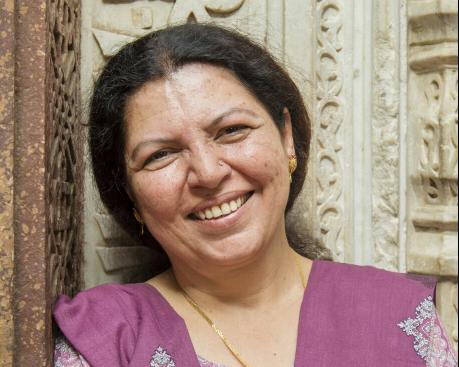The fascinating story of korma, and a secret family recipe

"Masala aise bhuno jaise dushman ka kaleja (roast your spices as passionately as if it were the enemy's heart)."
This instruction - not meant to be taken literally - by my grandmother is the story of korma, a dish that is infused with labour, love and passion but one that delivers magic when done right.
The word Mughlai for a particular cuisine is actually a misnomer, as actual Mughal dishes were far blander than what we are served under that name.
The Central Asians were nomadic warriors.
For them, cooking was on the go. Many a time they would be riding with marinated meat in their saddle-bags, which would need less time to cook when they set camp at night.
What we eat today is an amalgamation of these basic dishes influenced by indigenous and Persian cuisines. In India, most dishes use generous amounts of oil and spices, especially chilli, which are not native to Central Asian food.
When one speaks of Mughlai food you immediately think of the most famous of them all, the Korma. Though in the Perso-Arabic script we write it with a 'Q', history suggests that it could possibly be Korma and not Qorma.
Like the rose, it tastes just as spectacular by any name.
History tells us of a Central Asian dish called ashqorma/qorma/ kuverma, and it is this dish that was adapted by the Rajput cooks in Akbar's kitchen and named Korma after the Rajput warrior tribe 'Kurma'.
However, what we eat today was perfected in the kitchens of the Awadh Nawabs with a lot of Persian influence to adapt to Indian tastes. In Iran itself as I found out, food is quite bland.
Korma literally means braising the meat, and in korma the meat is braised in oil (traditionally it was desi ghee), yogurt and spices, then simmered in water till tender.
For festive occasions, blanched and finely ground cashews were also used as thickening agents. For everyday use peanuts can be substituted.
When we were growing up, korma was made only for parties as it involves a tedious amount of roasting of the meat and masalas.
Daily meals at home were primarily Qaliyas, a meat preparation with turmeric and vegetables. We were taught that the base of korma is fried onion paste and yogurt and haldi is never added to it. Qaliya on the other hand uses haldi and raw onion paste.
My mother hated cooking and couldn't understand my passion for it. Fortunately for my father, who was a foodie, I had inherited my Dadi's (paternal grandmother) skill and passion for cooking. I spent many an hour watching her cook.
In those days we had a chulha (coal stove) and on winter evenings, we would gather around it in the kitchen for hot chapattis off the chulha and stories. It was one of those times, when I asked her about the inordinate amount of time she was spending on roasting the masala that she gave me the instruction about roasting with which I started this piece.
It wasn't just a figure of speech, it was the philosophy with which she cooked - she put her heart in it.The trick in cooking any meat dish is in the 'bhunna' or roasting of the masala. Too little and it looks pale and tastes insipid; too much and it will taste bitter.
There are as many versions of Korma recipes as there are cooks, but I want to share our delicious but simple-to-cook family recipe - with some tips on how to get it right.
I am a foodie and I like to cook as well as eat. Over time I have simplified recipes and realised that regular cooks - for whom these dishes may be unusual - need a lots of tips on how to get it right, so I am sharing some of them.
The 3 don'ts of traditional North Indian Korma
1. Haldi is not added
2. No tomatoes are used
3. Garnish of coriander leaves is only done on Qaliya, not on Korma
And the 5 rules for getting it right
Rule no 1: the onions should be finely sliced and fried just the right golden brown colour.
If underdone, the colour and tatse of the korma will be pale and dull. If you burn or over-brown the onions, you're back to the dullish brown colour, this time with a bitter taste. The trick of great korma is in these details.
Rule no 2: don't add salt till the masala has been roasted as it will splatter.
Rule no 3: during the roasting process keep adding dashes of yogurt so that the masala doesn't stick to the pot. The reason hotel korma tends to be so oily is because they add lots of oil while roasting to cut down on time and effort. If you love your arteries as much as you love good food, use yogurt.
Rule no 4: the meat should be well cut. Trim all fat from it as fat gives it a very oily appearance and taste, as well as an uninviting smell. The best meat is from the shoulder or rump (raan).
Rule no 5: open the pot/pressure cooker only when the steam has completely escaped or else the dish will lose colour and the meat becomes tough.
Our family recipe for mutton or chicken korma
Meat or chicken: 1/2 kg; vegetarians: I substitute soya nuggets for my daughter who is a vegetarian and it tastes just as good.
1 big onion: finely chopped and fried golden brown
I tbsp each of ginger and garlic paste
1 tbsp coriander powder: lightly roasted in a tawa or pan. Keep stirring to prevent burning. Should be removed the minute it changes colour and gives off a fruity aroma
1tbsp garam masala powder (recipe below for those who want to make a fresh batch at home)
2 green cardamoms
3 bay leaves
1/2 to 1 tbsp kashmiri chilli powder (for colour and less spice). You can use regular chili powder if you like spicy food
5-7 cashews or groundnuts lightly roasted and made into a paste with a little water
1/2 tbsp dessicated coconut - roasted lightly and made into a paste
1/2 cup yogurt
salt to taste
1/2 cup vegetable oil
Method
1. Marinate your meat in 2 tbsp yogurt, 1 tbsp ginger-garlic paste and a small amount of salt for 2-3 hours. These ingredients are in addition to those listed for the dish. This is particularly important if you are making chicken korma as the meat is very bland and tasteless.
2. Heat oil. Add onions to it. Fry till golden brown. Drain and spread on a paper napkin to absorb excess oil. Lighly crush or grind it with a dash of yogurt. Set aside.
3. Add cardamom and bay leaves to the oil. When they splutter, add the marinated meat, shaking off the excess liquid. Fry on high heat for a few minutes so its juices are sealed inside.
Drain the meat and set aside.
4. Now add the ginger-garlic paste, coriander powder and the rest of the marinade and chilli powder to the oil. I don't add raw onion paste to my korma as I like a light gravy. In case you prefer a thick gravy, add one small raw onion ground to a paste.
Keep adding dashes of yogurt and stirring till it stops sticking to the sides of the pot and gives off a rich aroma. The gravy should almost glow.
5. Add ground cashews, coconut, fried onion paste, the garam masala and stir for a bit. Add any left over yogurt and stir.
Now add the meat, salt to taste, one cup water and and pressure cook (for mutton), or cook in a covered pot (if chicken) for 15 minutes.
If you want it richer, add a tbsp of fresh cream.
I don't like the taste so I don't add it but traditionally a dash of kewra is added to korma.
Garnish with slivers of almonds, serve, and feel like royalty.







![BJP's Kapil Mishra recreates Shankar Mahadevan’s ‘Breathless’ song to highlight Delhi pollution [WATCH] BJP's Kapil Mishra recreates Shankar Mahadevan’s ‘Breathless’ song to highlight Delhi pollution [WATCH]](https://images.catchnews.com/upload/2022/11/03/kapil-mishra_240884_300x172.png)

![Anupam Kher shares pictures of his toned body on 67th birthday [MUST SEE] Anupam Kher shares pictures of his toned body on 67th birthday [MUST SEE]](https://images.catchnews.com/upload/2022/03/07/Anupam_kher_231145_300x172.jpg)






